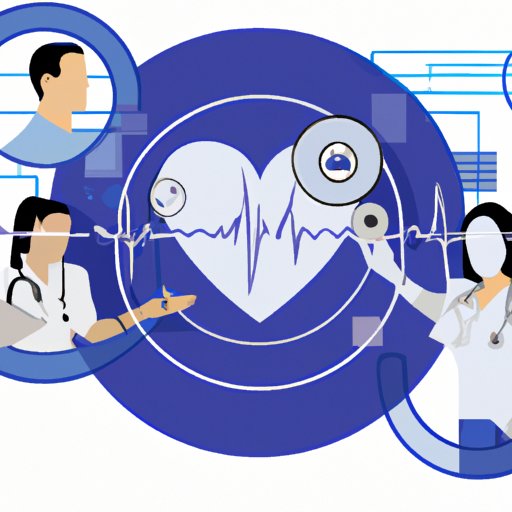Introduction
Healthcare technology is a broad term used to describe any type of technology that is used in the healthcare industry. This can range from medical devices, such as MRI machines, to software applications that help manage patient records. The goal of healthcare technology is to improve the quality of care by making it easier for healthcare providers to diagnose and treat patients. In this article, we’ll explore what healthcare technology is and how it helps, the impact on the quality of care, how it affects patient engagement, current trends in healthcare technology, and the challenges of implementing new technologies.
A Guide to Healthcare Technology: What It Is and How It Helps
Healthcare technology can be divided into two main categories: hardware and software. Hardware refers to physical devices, such as imaging machines or lab equipment, while software includes applications and programs that are used to store and manage data. Healthcare technology can also include wireless systems, such as Bluetooth, which allow healthcare providers to communicate with each other remotely.
The use of healthcare technology has many advantages. It can help streamline processes, reduce errors, and improve communication between patients and providers. It can also provide access to real-time patient data, allowing healthcare providers to make more informed decisions about diagnosis and treatment.

The Impact of Healthcare Technology on Quality of Care
Healthcare technology can have a positive impact on the quality of care provided to patients. Studies have shown that the use of healthcare technology can lead to improved access to care, increased accuracy of medical records, and better patient outcomes.
Improved access to care is one of the most significant benefits of healthcare technology. By using electronic health records (EHRs) and telemedicine, healthcare providers can reach more patients, faster. This is especially important in rural areas where access to care is often limited.
Another benefit of healthcare technology is the increased accuracy of medical records. With EHRs, all patient information is stored in the same place, making it easier for healthcare providers to access and update. This reduces the risk of errors and ensures that the patient receives the best possible care.
Finally, healthcare technology can lead to improved patient outcomes. With access to real-time data, healthcare providers can quickly identify potential issues and take appropriate action. This can help prevent serious illnesses and improve overall health.

Examining the Role of Healthcare Technology in Patient Engagement
Healthcare technology can also play an important role in patient engagement. By using online portals and mobile applications, patients can easily communicate with their healthcare providers and stay up to date on their care. This can help increase patient education and involvement in their own care, leading to improved patient satisfaction.
Healthcare technology can also help to bridge the gap between patients and providers. With digital communication tools, such as video conferencing and text messages, patients can easily reach out to their healthcare providers whenever they need to. This can help to ensure that patients get the support they need and feel connected to their care team.
An Overview of Current Trends in Healthcare Technology
As healthcare technology continues to evolve, new trends are emerging. Mobile health applications, wearable devices, and telemedicine are just some of the ways that healthcare providers are leveraging technology to improve the quality of care.
Mobile health applications allow patients to access their health information anywhere, anytime. These apps can be used to track symptoms, set reminders for medications, and even book appointments with healthcare providers. Wearable devices, such as fitness trackers, can monitor a person’s health and send real-time data to their healthcare provider.
Telemedicine is another trend that is gaining popularity. This type of technology allows healthcare providers to provide remote care to patients. With telemedicine, patients can receive care without having to leave their homes, making it easier to access care in rural areas.

Understanding the Challenges of Implementing Healthcare Technology
While healthcare technology can offer many benefits, there are also some challenges associated with its implementation. Cost is one of the biggest considerations, as healthcare organizations must invest in new technology and train staff on its use. There is also the challenge of ensuring data security, as sensitive patient information must be kept safe and secure.
Finally, healthcare organizations must consider the training needs of their staff. New technology can be difficult to learn and understand, so it is important that staff members receive adequate training and support to ensure they can effectively use the technology.
Conclusion
Healthcare technology has the potential to revolutionize the way healthcare is delivered. From improved access to care to increased patient satisfaction, the benefits of healthcare technology are numerous. However, there are also challenges associated with its implementation, including cost considerations and data security. As healthcare technology continues to evolve, it is important to understand the implications and challenges associated with its use.
In conclusion, healthcare technology can greatly improve the quality of care provided to patients. By understanding the different types of healthcare technology, its benefits, and the challenges associated with its implementation, healthcare organizations can ensure they are taking full advantage of the technology available to them.
(Note: Is this article not meeting your expectations? Do you have knowledge or insights to share? Unlock new opportunities and expand your reach by joining our authors team. Click Registration to join us and share your expertise with our readers.)
